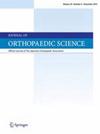利用三维磁共振成像对外侧踝关节韧带附着位置进行内部和相互测量的可靠性。
IF 1.5
4区 医学
Q3 ORTHOPEDICS
引用次数: 0
摘要
背景:我们的目的是利用三维磁共振成像评估外侧踝关节韧带附着位置的内部和相互测量可靠性:我们对 54 名平均年龄为 43 岁、接受过三维踝关节磁共振成像且外侧韧带正常的参与者进行了分析。在重建图像中确定了腓骨远端、距骨和小方骨的骨性地标。此外,还确定了距腓前韧带和小方腓韧带附着点的中心。测量地标和附着点之间的距离。两名评分员进行了两次测量,并计算了评分员内部和评分员之间的类内相关系数:结果:对距胫骨前韧带附着物的测量结果,评分者内部的类内相关系数在 0.71 至 0.96 之间;对方腓韧带附着物的测量结果,评分者内部的类内相关系数在 0.77 至 0.95 之间。除了距骨腓骨前韧带上束与腓骨不明显结节之间的距离外,其他测量的类间相关系数均高于 0.7。单束距骨前韧带的腓骨附着点距离下端13.3毫米,43%位于腓骨远端前缘。双束韧带的上束和下束分别位于43%和23%处。小腿腓骨韧带腓骨附着点距离下端5.5毫米,位于腓骨远端前缘的16%处:结论:通过三维磁共振成像确定的距腓前韧带和小方腓韧带附着位置的测量结果非常可靠。这种测量方法提供了外侧踝关节韧带解剖的活体解剖数据。本文章由计算机程序翻译,如有差异,请以英文原文为准。
Intra- and interrater measurement reliability of lateral ankle ligament attachment locations using three-dimensional magnetic resonance imaging
Background
We aimed to evaluate the intra- and interrater measurement reliability of the lateral ankle ligament attachment locations using three-dimensional magnetic resonance imaging.
Methods
We analysed 54 participants with a mean age of 43 years who underwent three-dimensional ankle magnetic resonance imaging and had normal lateral ligaments. Bony landmarks of the distal fibula, talus, and calcaneus were identified in the reconstructed images. The centers of the anterior talofibular ligament and calcaneofibular ligament attachments were also identified. The distances between the landmarks and attachments were measured. Two raters performed the measurements twice, and intra- and interrater intraclass correlation coefficients were calculated.
Results
The intrarater intraclass correlation coefficient values were between 0.71 and 0.96 for the anterior talofibular ligament attachment measurements and between 0.77 and 0.95 for the calcaneofibular ligament attachments. The interrater intraclass correlation coefficient was higher than 0.7, except for the distance between the anterior talofibular ligament superior bundle and fibular obscure tubercle. The fibular attachment of a single-bundle anterior talofibular ligament was located 13.3 mm from the inferior tip and 43% along the anterior edge of the distal fibula. The superior and inferior bundles of the double-bundle ligament were located at 43% and 23%, respectively. The calcaneofibular ligament fibular attachment was 5.5 mm from the inferior tip, at 16% along the anterior edge of the distal fibula.
Conclusion
The measurements of anterior talofibular ligament and calcaneofibular ligament attachment locations identified on three-dimensional magnetic resonance imaging were sufficiently reliable. This measurement method provides in vivo anatomical data on the lateral ankle ligament anatomy.
求助全文
通过发布文献求助,成功后即可免费获取论文全文。
去求助
来源期刊

Journal of Orthopaedic Science
医学-整形外科
CiteScore
3.00
自引率
0.00%
发文量
290
审稿时长
90 days
期刊介绍:
The Journal of Orthopaedic Science is the official peer-reviewed journal of the Japanese Orthopaedic Association. The journal publishes the latest researches and topical debates in all fields of clinical and experimental orthopaedics, including musculoskeletal medicine, sports medicine, locomotive syndrome, trauma, paediatrics, oncology and biomaterials, as well as basic researches.
 求助内容:
求助内容: 应助结果提醒方式:
应助结果提醒方式:


